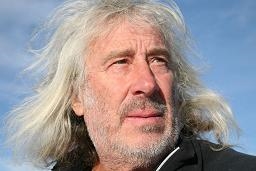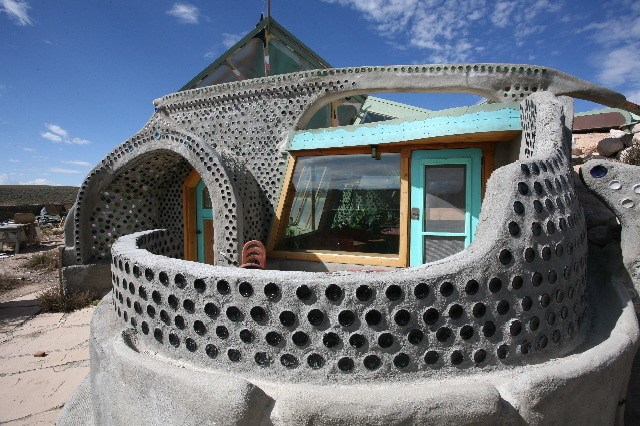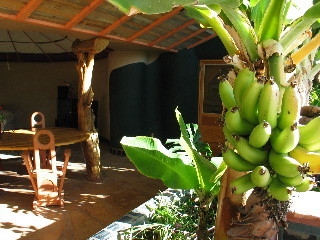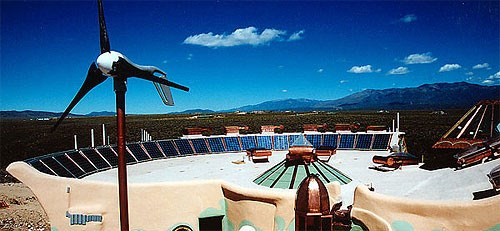 |
| Michael Reynolds (Earthship.net) |
It all started in the 70's. Michael Reynolds, a newly minted architect from the University of Cincinnati heard through the media that everyone was littering the streets and highways with aluminum cans. "I responded to that by building a house out of those thrown away cans. I was an architect but now I'm a biotect." He created the alternative word Biotecture to describe "the profession of designing buildings and environments with consideration for their sustainability. A combination of biology and architecture." Michael Reynolds builds Earthships and teaches anyone who will learn how to build them, too. He describes an Earthship as "a fully sustainable building made with biproducts of our society. It is a building that will take care of you in every way: food (year round green house), heating, water, air and sewage disposal. He tells me, "Earthships are the living model of the future that goes far beyond house and architecture."
Michael Reynolds is a self-described "guy who's trying to do some sustainable housing for the future." He is a passionate advocate for sustainable living. He believes our consumerist society is destroying our natural resources and eco-systems and that the only "logical" thing to do is to use the discards of our currently unsustainable lifestyle to create sustainable housing. When asked about the common misconceptions of his work, he replied, "Well, it's a lack of holistic understanding of the scope of (biotecture). When we started, some people just thought we were building out of recycled materials. Then others began to see we were building sustainable buildings out of recycled materials." It is this "logical" paradigm for building that Reynolds has been advocating for more than thirty years. "We need to live in an entirely different way and that is what we are hoping to find and present to people."
 |
| Inside an Earthship (earthship.org) |
Michael Reynolds has been called the King of Garbage, Garbage Architect, Tsunami Warrior and most recently, "Garbage Warrior." This last moniker was given him by Oliver Hodge, the producer of the film with the same name. This documentary chronicles Michael's battle against outdated zoning laws and corporate-friendly building ordinances in order to create off-the-grid houses, using materials found in garbage dumps: tires, bottles, aluminum cans, cardboard, plastics and even panels from thrown away refrigerators, stoves and washing machines. Michael says, "Everything we are doing is a response to the media. We knew in the 70's that we were running out of fuel and water. I was inspired to create a way of life that responds to those problems. There are mountains of tires around the world, and no one knows what to do with them. Hawaii actually ships its used tires to California." Michael's earthship designs use discarded tires to create incredibly strong foundations. After filling the tires with earth and stacking them like bricks, the resulting walls are so thick, they aid in temperature retention. Coupling this feature with year-round greenhouses allows each earthship to maintain a temperature of 72 degrees, regardless of where it's located. "Once I added the concept of thermal mass by beating dirt into a tire, I created a low-tech, readily available and easy-to-learn method of building. I couldn't have conceived of a better material than tires to build with."
 |
| Phoenix Earthship (earthship.org) |
So who lives in these "Earthships"? Michael told me that in the beginning, some thirty years ago, it was young hipsters, "willing to go out and try something new." Most of these Earthship "communities" exist outside of Taos, New Mexico, where Michael is headquartered, but as word catches on, his designs have spread to every corner of the globe. "In view of the scary things going on with the planet - whatever you want to call it, global warming, climate change - and it doesn't matter who caused it - the potential of the earth to accommodate humanity is in a precarious position." Now that the climate crisis is common knowledge, every type of person is jumping on board the Earthship movement - young, old, rich, poor, famous, educated and not, because they are seeing this will help them survive in an increasingly inhospitable future. There are several thousand earthships, worldwide and in all kinds of climates, from the mountains in Bolivia to Japan to Europe and all over North and South America. When the tsunami hit the Bay of Bengal several years ago, Michael and his team were invited to Andaman Island and built an Earthship out of the garbage from the devastated island that still stands. The dome-shaped one-room house is hurricane/earthquake proof and is built to collect rain-water. This is an important feature since the rising tide overwhelmed the community's single fresh-water well.
In July 2008, Michael spent a month in Bonaire building a bungalow where many local eyes were opened to the possibilities that exist in sustainable housing. Using garbage for construction materials has obvious benefits for the island-dweller. But when that same house is powered by the ever-present sun, when it collects fresh water with its unique shape and provides fertilizer from a self-contained sewage treatment and composting system, suddenly, "shelter" is playing an integral role in providing "food" and "water."
 |
| Year round banana crop inside Earthship (earthship.org) |
Michael's biggest frustration on this path has been preexisting laws, regulations, codes, traditions and cultures that, "make people cling to things that will not take care of them in the future. What is going to take care of us is raw logic. Classic beautiful Edinburgh buildings in Scotland will not take care of you in the winter, it gets cold. These stigmas will fall apart as the planet gets worse and worse."
With the urgent environmental crises currently affecting the planet, it may be time to listen to a visionary like Michael Reynolds. His inventive approach to sustainable housing directly addresses a number of problems that seem to be coming to a head. Over-burdened landfills and disappearing forests are both mitigated when garbage becomes a building material. Shortages of fresh water are eased when individual houses supply their occupants' needs. Off-the-grid homes running on solar and wind power not only ease the burden on the power grid, they give their occupants independence from increasingly expensive electricity bills. And when homes are designed to supplement food supplies with built-in greenhouses and waste treatment/composting systems that supply fertilizer, their occupants' lifestyles become both environmentally and economically sustainable. What's more, Earthship inhabitants actually become an active and benevolent part of their local ecosystem, a hand-in-hand communing with nature that many of Michael's converts now say, given the choice, they wouldn't live without.
 |
| Energy Roof (earthship.org) |
That's the beauty of an earthship. It uses all parts of the buffalo and it works in all climates. And since Michael and his team are currently developing his designs to use in retrofitting existing structures, sustainable housing is getting closer and closer for those of us who can't afford to start from scratch. Interested in building your own Earthship? Book a few nights in one in Taos, New Mexico to see if you really want to live in one. If you're interested in building one in your part of the world, there are books, DVDs and CDs available, as well as ongoing lectures, seminars and demonstrations. Everything you want to know and learn about Earthships and sustainable housing and living is somewhere on their vast website, www.earthship.net.
So, who do you think would be the hero of such a visionary man? Not surprisingly, another visionary - "Noah was out in the middle of the desert and he built a boat that made him look like a fool. That story, that guy is something I can relate to. Thirty-five years ago I saw dark clouds on the horizon - you just had to look, to visualize. Lots of people saw it but weren't inspired to do anything. They thought I was a fool, going to the dump, thought I was a fool for recycling garbage before recycling existed."
Not many people think Michael Reynolds is a fool anymore. And after thirty-seven years of being simultaneously condemned and praised, Michael says he finds it surreal, but gratifying, to finally be recognized for doing something reasonable. But for my hero, Michael Reynolds, everything he's done; from pounding earth into tires with a sledge-hammer, to scouring the dump for plastic bottles and aluminum cans, to proposing changes before the New Mexico state legislature, has been more than reasonable; it's "logical."
Page created on 9/12/2008 11:34:40 AM
Last edited 1/5/2017 9:42:46 PM
In a recent blog Michael wrote: Carbon Neutral Buildings - NOW
"Here in the early part of the twenty first century we find ourselves trying to react appropriately to the changing climate of the earth. We attribute part of this changing climate to the activities of humans, specifically relating to the CO2 emissions from these human activities. We have also observed that these changes are happening faster than we expected from previous observations and that between 30% and 50% of the CO2 emissions are directly related to and coming from buildings. There is, in fact, at this point, a certain urgency relative to just how and when we react."
www.earthship.net
Major Objectives:
To reduce the economic and institutional barriers between people and sustainable housing.
To begin reversing the overall negative effect that conventional housing has on the planet.
To create a less stressful existence for people in an effort to reduce the stress that they in turn place on the planet and each other.
To interface economics and ecology in a way that immediately and tangibly affects current pressing problems with existing life styles.
To provide a direction for those who want to live in harmony with their environment.
To empower individuals with the inarguable forces of nature.
To find and distribute knowledge about sustainable lifestyles.